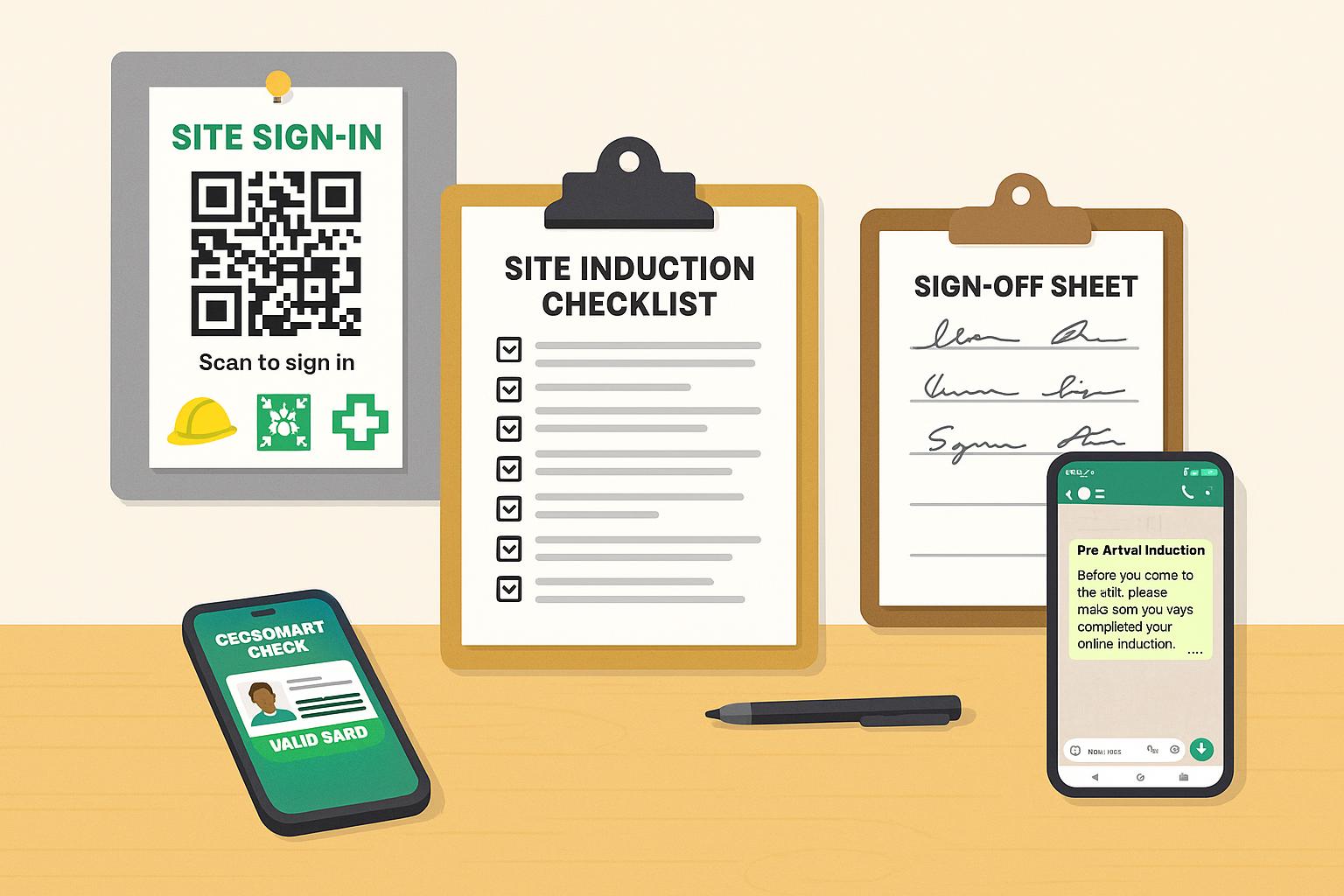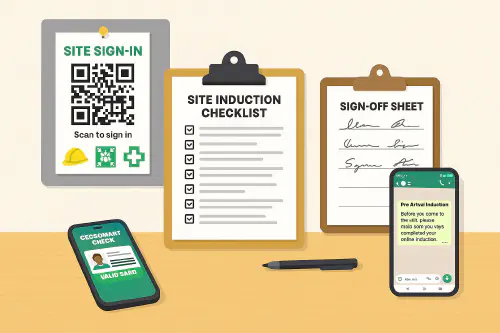
Site induction template for small contractors: what to include, printable checklist and digital options
Site induction template for small contractors: what to include, printable checklist and digital options
Category: Hiring, Training & HR • Niche: inductions, CDM 2015, CSCS Smart Check, WhatsApp workflows, QR sign-in
Contents
- Who this is for
- Quick answer
- The essential site induction template (printable)
- Digital options: QR sign-in, CSCS Smart Check and WhatsApp pre‑briefs
- How to deliver a site‑specific induction in 15 minutes
- Record keeping and evidence that stands up to audits
- Troubleshooting and common pitfalls
- Further reading
- FAQ

Clipboard with site induction checklist, QR sign-in poster, CSCS Smart Check on phone and WhatsApp pre-brief on a tidy UK site office desk
Who this is for
Small contractors, micro firms and one‑man bands who need a clear, simple site induction that still meets CDM 2015 and HSE expectations. This guide keeps it practical and shows quick digital wins that cut admin on busy jobs.
Quick answer
Your induction must be site‑specific, proportionate and delivered to everyone before they start work. Cover: who’s in charge, key risks and controls, site rules, first aid and emergency procedures, and how you’ll communicate on site. Keep a record of who was inducted, by whom, when, and what was covered. CDM 2015 puts the duty on the principal contractor to ensure this happens, and every contractor must make sure their workers get a suitable induction.
The essential site induction template (printable)
Use this as a one‑page checklist you can print and tick through. Add your site logo/details and staple it to your daily sign‑in sheet.
- Project details: site address, principal contractor, site manager, start date, phase
- Roles and reporting: who to report to, daily brief time/location
- Significant risks on this site today: working at height; moving plant; excavations; live services; fragile roofs; hot works; dust/silica; noise; manual handling; COSHH; adjacent public; restricted areas; water/proximity to drowning; HV/overhead lines; lifting operations; prefabricated heavy components
- Controls in place: exclusion zones; signage; permits; edge protection; fall arrest; banksman; CAT and Genny; service isolations/LOTO; fire watch; dust suppression; hearing/respiratory protection; traffic routes; pedestrian walkways; barriers; lighting
- Site rules: PPE; sign‑in/out; smoking/vaping areas; housekeeping; welfare; hot works permit; RAMS must be briefed; no lone working in X areas; speed limit; parking; spill control; waste segregation; no alcohol/drugs; photography policy
- Access and logistics: site access routes; delivery times; storage; lifting points; craneage; laydown areas
- Emergency arrangements: alarm; muster point; fire wardens; spill kits; first aiders and kits; nearest A&E; incident/near‑miss reporting process
- Communications: toolbox talks schedule; noticeboard location; change briefing process; how to raise concerns
- Verification checks completed: right‑to‑work seen (where relevant); CSCS/competence checked; brief delivered; understanding confirmed; names and signatures
Tip: keep the brief to 10–15 minutes for low‑risk phases. For higher‑risk phases or when conditions change, deliver a targeted re‑induction or toolbox talk.
Digital options: QR sign‑in, CSCS Smart Check and WhatsApp pre‑briefs
- QR sign‑in: Print a QR code that opens your sign‑in form. This speeds up attendance logging and helps with emergency roll‑calls. See our guide: Site sign‑in on construction jobs: QR code vs kiosk and how to set it up.
- CSCS Smart Check: Use the app to verify CSCS‑logoed cards at induction and record the check in your log. Official guidance: CSCS Smart Check.
- WhatsApp pre‑arrival message: Send a short message the day before with parking, PPE, start time and site rules link. This removes basic questions and speeds up your morning.
Example pre‑arrival WhatsApp message:
“Hi [Name] — tomorrow’s start is 07:30 at [postcode]. Parking on [street]. PPE: boots, hard hat, hi‑vis, gloves, eye protection. Report to [site manager]. No hot works unless permitted. Reply if you need RAMS or drawings in advance.”
How to deliver a site‑specific induction in 15 minutes
- Sign‑in and verify
- Get names on the sign‑in and check competence/CSCS via Smart Check. If a visitor is escorted, do a shorter, proportionate brief.
- Project overview and roles
- Who’s in charge, how to report issues, when daily brief/toolbox talks happen.
- Today’s top three risks and controls
- Keep it specific to this phase and location. Walk the area for 2 minutes if needed.
- Site rules and logistics
- PPE, traffic, restricted areas, welfare, housekeeping, deliveries.
- Emergencies and first aid
- Muster point, alarms, first aiders and kits, incident reporting.
- Check understanding and sign
- Ask one or two questions to confirm understanding for higher‑risk tasks, then get signatures.
Record keeping and evidence that stands up to audits
- Keep the signed template with your daily records or upload a photo/PDF to your job folder structure.
- Log CSCS checks: card type, expiry, person’s name, and who verified it.
- Keep copies of RAMS brief records and toolbox talk sign‑offs.
- If English isn’t the worker’s first language, provide translated induction materials or use a bilingual supervisor/interpreter. See: How to translate RAMS and site inductions safely with AI.
Troubleshooting and common pitfalls
- Too generic: Template is fine, but make it site‑specific on the day. Add the top risks and controls for this phase.
- No record of CSCS/competence: Verify and log at induction. The CSCS Smart Check app works offline for scanning QR codes and synchronises when back online.
- Language barriers: Don’t just read faster; provide translated bullet points and visuals for key rules.
- Visitors vs workers: Visitors still need a proportionate brief; escort where appropriate.
- Changes on site: When a new phase introduces new risks, do a 5‑minute re‑induction or toolbox talk.
Further reading
- HSE: Site rules and induction
- HSE: Principal contractors – roles and responsibilities
- CDM 2015: Regulations (legislation.gov.uk)
- Build UK: How to be a Smart Site!
- TrainAR Academy: Construction site induction video: script, kit and a simple process that meets CDM
- TrainAR Academy: How to set up QR code site induction and CSCS Smart Check that records checks
FAQ
Do I need to induct every single person, even for a 10‑minute visit?
Yes, but keep it proportionate. Escorted visitors can get a short hazards and emergency briefing. Workers must have a full, site‑specific induction before starting.
Can I use a generic induction across multiple projects?
Use a common template, but you must tailor on the day to the specific site, phase and risks. CDM expects a site‑specific induction.
Is a CSCS card legally required?
Not by law, but many clients and principal contractors require CSCS or equivalent proof of competence. If used, verify it at induction with CSCS Smart Check.
How do I prove I delivered the induction?
Keep a signed checklist, photos of the briefing materials, and a log of who attended. Digital sign‑in forms with time‑stamps are ideal.
What if English isn’t the worker’s first language?
Provide translated materials or use a bilingual supervisor/interpreter. Keep a record of how you made the brief understandable.
Can I send induction info ahead of time?
Yes. Send a pre‑arrival WhatsApp message with parking, PPE and key rules. You still need a site‑specific briefing on arrival.
Want to slash training times and increase revenue per Engineer? Join our Waitlist: https://trainar.ai/waitlist